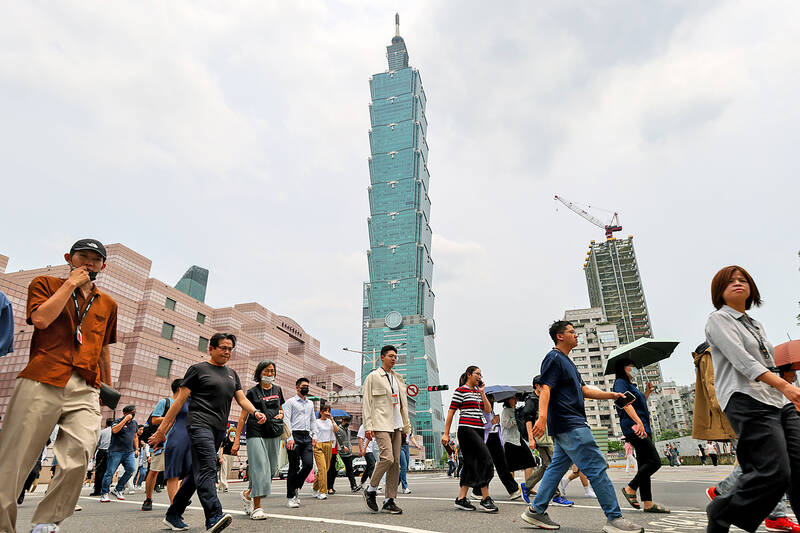Taiwan remained the fifth-largest net creditor last year as its net international investment position (NIIP) hit another new high, the central bank said on Friday.
Taiwan’s external financial assets totaled US$2.91 trillion at the end of last year, up US$247.04 billion, or 9.3 percent, from a year earlier, while the nation’s external financial liabilities reached US$1.17 trillion, up US$183.12 billion, or 18.5 percent, from a year earlier, data compiled by the central bank showed.
The difference between Taiwan’s external financial assets and liabilities hit a new high of US$1.74 trillion, up US$63.92 billion, or 3.8 percent, from a year earlier, positioning the nation as the world’s fifth-largest net creditor, the data showed.

Photo: EPA-EFE
The NIIP is the difference between a country’s external financial assets and its external financial liabilities, the central bank said.
Japan took the top net creditor spot with a NIIP of about US$3.44 trillion last year, followed by Germany (US$3.20 trillion), China (US$2.19 trillion) and Hong Kong (US$1.78 trillion), the central bank said.
The rise in Taiwan’s external financial assets last year stemmed partly from a boom in global stock markets, which pushed up sharply the value of overseas shares held by investors in Taiwan, it said.
Stock markets worldwide rose about 17 percent last year, helping Taiwan’s portfolio investments rise 14.1 percent from a year earlier to US$1.39 trillion, it said.
The nation’s cumulative outbound investments also hit a new high of US$500.14 billion last year, up 10.9 percent from a year earlier, as restructuring of global supply chains led many Taiwanese companies to send more of their funds overseas, it said.
The central bank was referring to companies such as contract chipmaker Taiwan Semiconductor Manufacturing Co (台積電), which has poured funds into the US, Japan and Germany to build advanced wafer fabs to diversify its production bases.
Taiwan has long maintained a surplus in its current account, which mainly measures the exports and imports of a country’s merchandise and services.
The other big creditors, Japan, Germany and China, have also traditionally been net exporters, though Japan has recorded trade deficits over the past few years.
At the end of last year, Taiwan’s current account hit US$105.33 billion, up from US$100.93 billion as of the end of 2022, the central bank data showed.
External financial liabilities were boosted by cumulative foreign direct investment in Taiwan, which reached a new high of US$136.6 billion last year, up 9.8 percent from a year earlier.
In addition, total portfolio investments in Taiwan by overseas investors were up 33.5 percent from a year earlier to US$710.9 billion, the central bank said.
The higher portfolio numbers reflected, in part, the 26.8 percent rise in the TAIEX last year, it said.

Shares in Taiwan closed at a new high yesterday, the first trading day of the new year, as contract chipmaker Taiwan Semiconductor Manufacturing Co (TSMC, 台積電) continued to break records amid an artificial intelligence (AI) boom, dealers said. The TAIEX closed up 386.21 points, or 1.33 percent, at 29,349.81, with turnover totaling NT$648.844 billion (US$20.65 billion). “Judging from a stronger Taiwan dollar against the US dollar, I think foreign institutional investors returned from the holidays and brought funds into the local market,” Concord Securities Co (康和證券) analyst Kerry Huang (黃志祺) said. “Foreign investors just rebuilt their positions with TSMC as their top target,

REVENUE PERFORMANCE: Cloud and network products, and electronic components saw strong increases, while smart consumer electronics and computing products fell Hon Hai Precision Industry Co (鴻海精密) yesterday posted 26.51 percent quarterly growth in revenue for last quarter to NT$2.6 trillion (US$82.44 billion), the strongest on record for the period and above expectations, but the company forecast a slight revenue dip this quarter due to seasonal factors. On an annual basis, revenue last quarter grew 22.07 percent, the company said. Analysts on average estimated about NT$2.4 trillion increase. Hon Hai, which assembles servers for Nvidia Corp and iPhones for Apple Inc, is expanding its capacity in the US, adding artificial intelligence (AI) server production in Wisconsin and Texas, where it operates established campuses. This

US President Donald Trump on Friday blocked US photonics firm HieFo Corp’s US$3 million acquisition of assets in New Jersey-based aerospace and defense specialist Emcore Corp, citing national security and China-related concerns. In an order released by the White House, Trump said HieFo was “controlled by a citizen of the People’s Republic of China” and that its 2024 acquisition of Emcore’s businesses led the US president to believe that it might “take action that threatens to impair the national security of the United States.” The order did not name the person or detail Trump’s concerns. “The Transaction is hereby prohibited,”

Garment maker Makalot Industrial Co (聚陽) yesterday reported lower-than-expected fourth-quarter revenue of NT$7.93 billion (US$251.44 million), down 9.48 percent from NT$8.76 billion a year earlier. On a quarterly basis, revenue fell 10.83 percent from NT$8.89 billion, company data showed. The figure was also lower than market expectations of NT$8.05 billion, according to data compiled by Yuanta Securities Investment and Consulting Co (元大投顧), which had projected NT$8.22 billion. Makalot’s revenue this quarter would likely increase by a mid-teens percentage as the industry is entering its high season, Yuanta said. Overall, Makalot’s revenue last year totaled NT$34.43 billion, down 3.08 percent from its record NT$35.52